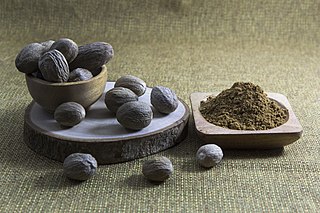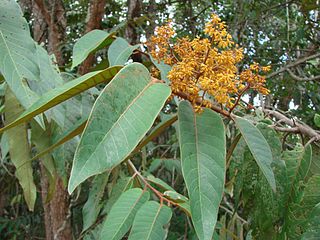
Nutmeg is the seed, or the ground spice derived from that seed, of several tree species of the genus Myristica; fragrant nutmeg or true nutmeg is a dark-leaved evergreen tree cultivated for two spices derived from its fruit: nutmeg, from its seed, and mace, from the seed covering. It is also a commercial source of nutmeg essential oil and nutmeg butter. Maluku's Banda Islands are the main producer of nutmeg and mace, and the true nutmeg tree is native to the islands.

Ilex aquifolium, the holly, common holly, English holly, European holly, or occasionally Christmas holly, is a species of flowering plant in the family Aquifoliaceae, native to western and southern Europe, northwest Africa, and southwest Asia. It is regarded as the type species of the genus Ilex, which by association is also called "holly". It is an evergreen tree or shrub found, for example, in shady areas of forests of oak and in beech hedges. In the British Isles it is one of very few native hardwood evergreen trees. It has a great capacity to adapt to different conditions and is a pioneer species that repopulates the margins of forests or clearcuts.

Myristica is a genus of trees in the family Myristicaceae. There are over 150 species, distributed in Asia and the western Pacific as far as Vanuatu.

The Myristicaceae are a family of flowering plants native to Africa, Asia, Pacific islands, and the Americas and has been recognized by most taxonomists. It is sometimes called the "nutmeg family", after its most famous member, Myristica fragrans, the source of the spices nutmeg and mace. The best known genera are Myristica in Asia and Virola in the Neotropics.
Nutmeg is a spice, usually obtained from the plant Myristica fragrans. It may also refer to:

The spice imperial pigeon is a species of bird in the family Columbidae. It is endemic to Indonesia, where it occurs in the eastern Moluccas and the Raja Ampat Islands. Its natural habitats are subtropical or tropical moist lowland forests and subtropical or tropical mangrove forests. It eats, and is an important disperser of seeds for, fleshy fruits.

Monodora myristica, the calabash nutmeg or African nutmeg, is a tropical tree of the family Annonaceae or custard apple family of flowering plants. It is native to tropical Africa from Sierra Leone in the west to Tanzania. In former times, its seeds were widely sold as an inexpensive nutmeg substitute. This is now less common outside its region of production. Other names of calabash nutmeg include Jamaican nutmeg, ehuru, ariwo, awerewa, ehiri, airama, African orchid nutmeg, muscadier de Calabash and lubushi.

Aglaia argentea is a species of plants in the family Meliaceae. It is a tree found in Australia, Brunei, India, Indonesia, Malaysia, Myanmar, Papua New Guinea, the Philippines, the Solomon Islands, and Thailand.

Myristica magnifica is a species of plant in the family Myristicaceae. It is native to Karnataka and Kerala in India. It is classified as an endangered species according to the IUCN Redlist. The plant grows in terrestrial but swampy habitats along streams in evergreen forests. These swamps get inundated during the monsoons and remain flooded year round.

Virola sebifera is a species of tree in the family Myristicaceae, from North and South America.
Bomberai Peninsula is located in the Western New Guinea region. It is south of the Bird's Head Peninsula, and Bintuni Bay separates the two peninsulas. To the west lies the Sebakor Bay and to the south Kamrau Bay. On the southeast Arguni Bay lies between the peninsula and the Bird's Neck Isthmus.

Agriculture in Indonesia is one of the key sectors within the Indonesian economy. In the last 50 years, the sector's share in national gross domestic product has decreased considerably, due to the rise of industrialisation and service sector. Nevertheless, for the majority of Indonesian households, farming and plantation remains as a vital income generator. In 2013, the agricultural sector contributed 14.43% to national GDP, a slight decline from 2003's contribution which was 15.19%. In 2012, the agricultural sector provides jobs to approximately 49 million Indonesians, representing 41% of the country's total labor force.

Myristica fragrans, commonly known as the nutmeg tree, is an evergreen species indigenous to the Maluku Islands of Indonesia. This aromatic tree is economically significant as the primary source of two distinct spices: nutmeg, derived from its seed, and mace, obtained from the seed's aril.

Fakfak, also known as the District of Fakfak, is a town in West Papua and seat of the Fakfak Regency. It had a population of 12,566 at the 2010 Census, which rose to 18,900 at the 2020 Census. It is served by Fakfak Airport. It is the only town in West Papua with a significant Muslim Indian and Arab Indonesian presence.

Macelignan (Anwulignan) is a lignan. It can be found in Myristica fragrans, the nutmeg.

Castanopsis argentea is an evergreen tree native to Indonesia, where it is known as sarangan. It is native to the islands of Java and Sumatra.

The satin berrypecker is a species of berrypecker in the family Melanocharitidae that was described in 2021. It is the only bird known to be endemic to the Bird's Neck in Western New Guinea, where it inhabits the Fakfak and Kumawa Mountains, two mountain ranges separated by 80 km of lowland rainforest. It inhabits mid-montane cloud forest with many ferns, mosses, and lichens and seems to prefer relatively open areas with sparser trees and more abundant tree ferns. It is known from elevations of 900 to 1,440 m in the Kumawa Mountains and 1,200 to 1,500 m in the Fakfak Mountains.

Myristica insipida, commonly known in Australia as Australian nutmeg, Queensland nutmeg or native nutmeg, is a small rainforest tree in the family Myristicaceae native to parts of Malesia, Papuasia and Australia. It is closely related to the commercially-important species of nutmeg, M. fragrans.

Myristica beddomei is a species of tree in the family Myristicaceae. It is endemic to the Western Ghats, India, where it is frequent in the mid-elevation wet evergreen forests and an important food tree of hornbills. The species has been earlier misidentified in regional floras and herbarium specimens as Myristica dactyloides Gaertn., the latter occurring only in Sri Lanka.
Myristica inutilis is a species of flowering plant in the nutmeg family, Myristicaceae. It is a tree native to the South Pacific, ranging from New Guinea through the Bismarck Archipelago and Solomon Islands to Vanuatu, Wallis and Futuna, and the Samoan Islands. It is not native to Fiji, but may be present in Tonga.















